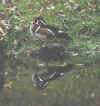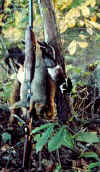| October 2007
The myriad of outdoor pleasures aren’t all first
line relatives of hunting, but these activities certainly rear their heads
through the month and one of the finest--though the rank-and-file are yet
to discover it--is jump-shooting wood ducks while hunting squirrels on
creeks, streams and rivers.
There are many ways to try this interesting and
productive activity, depending chiefly on the size of the creek, stream
or river you will go to. But no matter the size of the water you will try,
a requisite is ample cornfields bordering the waters for wood ducks love
corn--standing or harvested. Wood ducks and corn are next to flies in soup.
And corn is a staple of squirrels.
Whether floating a larger river, or riding Shanks
mare (walking), while bank stalking a smaller thread of water, one can
reasonably expect to bag his limit of two woodies and as many squirrels
on a good day. That turns into fine fare at the table.
Wood ducks are wary critters, though, so stealth
whether floating or bank stalking is a prime ingredient for the day. Personally,
I prefer secondary streams and bank stalking to floating a larger river
because a hunter on foot can be quieter and hunt more slowly. Walking also
puts one in closer touch with fall mushrooms and nuts encountered.
Incidentally, I usually pick the mushrooms I find
and store them in my hunting coat in the bread or paper sacks I always
keep in my pockets. The nuts usually are simply sampled for later harvest.
They may range from black walnuts to beechnuts.
Most of my time in stalking a creek or stream
will be spent on the high banks, hidden by brush or standing corn. Occasionally,
though, I sneak very carefully into a spot that offers a good view of the
water above and below my opposition to scan for ducks with the little binoculars
(they are carried on a strong strap around my neck).
In that area, one must remember that the wood
duck (Aix sponsa) lives up to it’s name. It is often found on wood,
as opposed to water. It is often found on the banks of waters--especially
when it is feeding. I often find them even perched in trees when they are
resting and I believe they even roost in trees at water’s edge.
I got my first lesson in this behavior one day
while jump shooting on Salt Creek’s Middle Fork. As I sneaked a big bend
in the creek, I could see (with my binoculars) a disturbance in the water
behind a floating log. The stalking was fairly easy, so I got on hands
and knees to get a really good shot at close range with the little Browning
Superpose cradled in my arms.
There were ducks on the water behind the log and
that shielded my presence from their view. I could get quite close, like
15 or 20 feet.
At even closer range, I struggled a bit to get
to a sitting position where I would “SHUSH” them to put them on the wing
for shooting. It was going to be duck soup.
However, the ducks behind the log delayed a bit--undoubtedly
surprised at my presence. This tactic took me aback and shots from both
barrels went awry. Not a feather fell. And simultaneously, 25 or 30 of
their brethren exploded from the limbs of a little ironwood tree on the
banks near the water.
With this bit of action now history, and the only
thing coming out of the barrels being wisps of smoke, I rolled over on
my back in the dry leaves (my unloaded gun at my side), and tried to reconstruct
the most unsuccessful turn of events. Fleecy clouds dotted the blue sky,
and as I reflected on the stalk, the flock of woodies wheeled past the
spot again well below the treetops--their wings creating a swoosh-swoosh
sound as they sliced the air amid squeals (almost of delight)--a rollicking
crew.
It was there, flat on my back with unloaded scattergun
at my side, that my dad’s words took real meaning: “little squealers like
wood,” hence their name.
I have hunted them for well over half a century
now, and I still can’t get enough of them--on the creek, on the dining
room table, or someplace between.
Although I hunt woodies some on the two forks
of White River, my choice of waters is one of the smaller creeks of the
state. There are many of them in the Muscatatuck River class, or smaller,
and they all host wood ducks in the late summer, when the families unite,
or until the first hard freeze hits. But, as noted earlier, streams that
are bordered by corn or soybeans are the best bet.
Such waters also are often frequented by beaver
colonies and they characteristically drag entire stalks of corn into the
water where they feed. This spells smorgasbord for the woodies, too. Such
spots will be recognized by foot wide beaver slides on the banks, and stalks
of corn on the water. If the woodies aren’t there, just hide well in shotgun
range and wait a spell. They probably will come.
Woodies also spend a lot of time during the day
just loafing in creek bends, under and around driftwood structure, or even
on the banks at the edge of the water.
I hunt them on foot by sneaking the banks, but
staying well away from the water. Another bit advice from my dad notes
that if the hunter can see the water, woodies can see, or hear, the hunter.
However, sound is not as critical as sight. Sounds may make woodies nervous
and more wary, but usually it does not put them to flight. Movement is
more critical than still sight. So if you are detected by woodies, freeze
in your tracks. Don’t try to conceal yourself by movement behind natural
cover. Just freeze. Try not to blink an eye.
I stay out of sight of water most of the time
as I move along a stream; occasionally, I slip carefully toward the water
until I can see it with binoculars. If there are disturbances on the water’s
surface, or if there is some kind of cover on the water, I try to get closer.
Of course, disturbances can be created by a variety of other animals, birds,
or many other factors.
One will, of course, have favored places--like
a number of bends on a number of waters, and these must be given special
attention--even sit hunted for a spell. Woodies move for many reasons.
If wood ducks see you, or otherwise detect your
presence, and simply swim away in one direction or another, don’t try to
catch them. Move in a wide circle away from the creek and slip back within
shooting range of the water. The ducks may come to you if you are well
hidden. Move cautiously, but as fast as possible. There may be other ducks
around.
When bank stalking, keep your eyes on the banks
as much as possible. There may be birds feeding on acorns and many other
seeds. Generally, though the water is most important as wood duck haunts.
But one must still be cognizant of the banks, driftwood collections, logs
and other form of natural cover found in streams. It is well to remember
to give such spots plenty of time to produce when you are in shooting distance
because woodies--like some other birds and animals--at times take some
time to flee, even though they have been aware of your presence. While
you are waiting for the possible explosion be alert and ready to fire.
I use several scatterguns for jump shooting woodies
and squirrels, but it is important to have a hard-shooting gun and strong
ammunition. I often load with three-inch magnum shells in a full choke
gun. Gauge is inconsequential, but the smaller the stream, the smaller
the gauge is a good rule of thumb. Twenty gauge is lighter--you got to
carry it--but 12 gauge will add to killing range. Either will handle squirrels.
At this point I must say, to stay within the law,
non-toxic shot must be used. I must also say non-toxic shot are not the
best load for squirrels, but they must be used if waterfowl are hunted
because of stupid federal regulations. We bow to them. Lead shot fired
on streams and rivers would not be a threat to waterfowl, and they are
the very direct cause of much crippling of squirrels. This comes from one
who has without doubt crippled and lost many squirrels, and it makes me
sad to think I do it.
Hunting slowly will assure plenty of opportunities
to bag both squirrels and wood ducks if the birds are using the waters
hunted.
Hunting a small stream or river will necessitate
moving from one bank to the other. On larger rivers this probably will
be no problem for a boat. Moving from one bank to the other can be a problem
on small streams, but nature helps solve the problem by felling trees across
streams (even rivers . . . natural bridges). Boots and socks--even trousers--can
be removed to cross at riffles and other shallow waters.
In addition to ducks and squirrels, I often find
hickory jacks (pleurotus ostreatus), a wonderful fall mushroom,
on driftwood collections and other woods. For harvesting these my hunting
coat always carries a bread sack or two.
There are, of course many other natural wonders
to encounter for just viewing or harvesting and many of them will be found
on streams and rivers . . . on a duck . . . er-r-r . . . squirrel hunt.
For example, a few years back I was on the middle
fork of Salt Creek near the town of Kurtz in Jackson County. It was a very
warm, bright day and I had gone to a cornfield to hot foot it back to my
car for lunch . . . with no ducks or squirrels for the pot.
While walking swiftly down the first row of corn,
I noticed what appeared to be a fog bank 10 or 15 feet above the earth
far ahead.
But I asked myself, “What would a fog bank be
doing out there on the hot, bright day.”
Arriving close hand at the scene, I discovered
a vine and fluffy seedpods I never before had seen or heard of . . . anywhere
or from anybody. It turned out to be virgin’s bower, a rare member of the
buttercup family (Clematis virginiana) climbing in ash saplings.
It made my lack of ducks and squirrels totally inconsequential.
My peanut butter-jelly sandwich never tasted so
good, and I appear to be the lone Hoosier who has viewed the plant.
It’s that time of year . . . almost!
Click on thumbnail
image for enlarged view.

|

|

|
| This
is the seedpod of virgin’s-bower. A cluster of seedpods on a vine in small
ash trees left the appearance of ground fog on a hot, sunny day. |
The
wood duck is one of our most beautiful, as well as best eating, ducks. |
This
shot tells the story of a wood duck-squirrel outing. My model 1100 supports
ducks and squirrels. |
|

